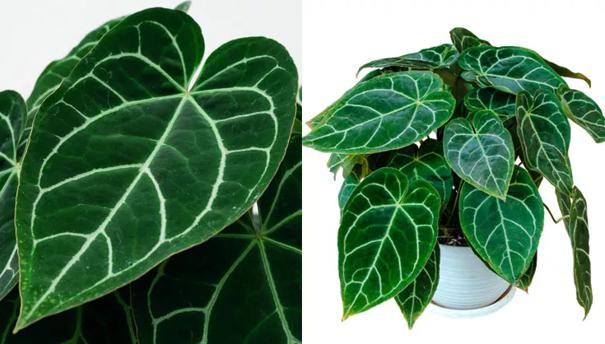How to Care for a Anthurium

As a houseplant, Anthurium don't need to grow on other plants (!), but it will appreciate conditions that mimic that of its native range — warm temps, humid air, and rich, loose soil. Read on to learn how to grow these beautiful plants in your home!
Types of Anthurium to Try
There are roughly 1,000 species of Anthurium; there are plenty of plants to try out! All Anthurium are characterized by their unique and exotic blooms, featuring a vibrant, waxy bract known as the spathe, surrounding a central tail-like inflorescence called the spadix. In addition to their long-lived flowers, Anthurium have gorgeous, heart-shaped leaves.
Anthurium andraeanum: A popular flowering houseplant, this species boasts bright red flowers, earning it the name "flamingo flower".
Anthurium andraeanum 'Baron': This cultivar has striking green and pink bracts.
Anthurium veitchii: Known for its long, pendulous leaves that can reach several feet in length, this impressive species is sometimes called "King Anthurium".
Anthurium crystallinum: This species is admired for its velvety, heart-shaped foliage in dark green with silvery veining.
Anthurium clarinervium: Known as heart leaf plant, it looks like A. crystallinum with deep green foliage.
Best Growing Conditions For Anthuriums
Light
Anthuriums are a bit picky about lighting. Direct sunlight can scorch their leaves, while too little light can result in fewer flowers. A spot near an east or west-facing window is ideal — they appreciate plenty of bright, indirect light.
Soil
This plant grows in a loose, highly organic, spongy potting medium with a small root system. A blend of peat moss, pine bark, and perlite or sand works well. During the growing season, fertilize every other month with a balanced, water-soluble fertilizer diluted to half-strength. Avoid over-fertilizing to prevent root burn.
Humidity
As a tropical forest native, Anthurium like moist, humid air. Consider placing your plant in a steamy bathroom, or boost humidity with a humidifier.
How to Care for Anthurium
Watering
To maintain optimal health for your Anthurium, water it when the top inch of the soil feels dry. While they thrive in consistently moist soil, it's crucial to avoid waterlogged conditions to prevent the risk of root rot. Ensuring proper drainage is essential for their well-being.
Pruning
While Anthuriums typically don't require frequent pruning, the removal of yellow or brown leaves can enhance the plant's appearance. Utilize clean, sharp scissors for any trimming to prevent the risk of infection.
Repotting
Consider repotting your Anthurium every two to three years or when it shows signs of becoming root-bound. Spring or early summer is the ideal timeframe for this task. Opt for a pot slightly larger than the current one to support optimal growth.
Propagation
If you wish to propagate your Anthurium, opt for the division method during repotting. Gently separate the root ball into smaller sections, ensuring each has several leaves and roots, and plant them in individual containers for successful propagation.
Common Problems with Anthuriums
Pests and Diseases
Be attentive to common pests such as aphids, mealybugs, and scale insects, as well as potential concerns like root rot and bacterial blight. Regularly inspect your Anthurium and promptly address any issues using appropriate measures to maintain its well-being.
Toxicity
Anthuriums are toxic to pets and humans if ingested. Their sap can also cause skin irritation, so handle with care, especially around pets and children.
Anthurium FAQs
Q: Why aren't my Anthuriums flowering?
A: Anthurium typically flower in late spring or summer. Lack of flowering is often due to insufficient light or inadequate fertilization. Ensure your plant is receiving bright, indirect light. Snip away spent blooms as they fade, and consider using a high-phosphorus fertilizer to encourage more blooms.
Q: How can I increase humidity for my Anthurium?
A: Anthuriums enjoy high humidity. You can increase humidity by placing a tray of water near the plant, using a humidifier, or misting the leaves regularly.
Q: Is it normal for Anthurium leaves to turn yellow?
A: Yellow leaves can indicate overwatering, poor drainage, or a nutrient deficiency. Make sure your pot has a hole at the bottom, and consider replacing your soil with a fresh batch to improve drainage.
It's hard not to be drawn in by the Anthurim's impressive foliage and striking blooms — provide your Anthurium with loads of humidity and warmth, and it will reward you with both!
Last updated: 02/05/2024
Print this Article:
Related Articles
Get the Dirt
Stay up to date on new articles and advice. Please fill out the information below.



